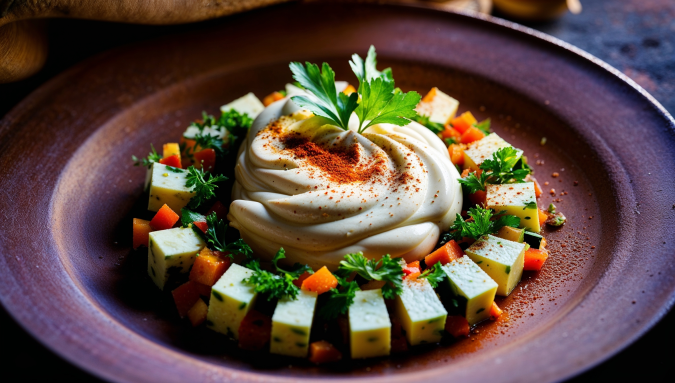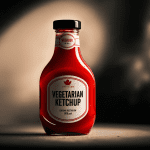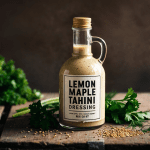Here’s a simple and delicious vegetarian mayo recipe, along with tips and variations to customize it to your liking.
Vegetarian Mayo Recipe
Ingredients
- ½ cup unsweetened soy milk (or aquafaba)
- 1 cup neutral vegetable oil (such as sunflower or canola)
- 1 teaspoon Dijon mustard
- 1 tablespoon apple cider vinegar (or lemon juice)
- ½ teaspoon salt (adjust to taste)
- Optional: 1 clove minced garlic or ½ teaspoon garlic powder for added flavor
Instructions
- Combine Ingredients: In a tall container (like a mason jar), add the soy milk, Dijon mustard, vinegar, and salt. If using garlic, add it here as well.
- Add Oil: Pour the oil on top of the mixture.
- Blend: Using an immersion blender, blend the mixture starting at the bottom of the jar for about 15 seconds. Gradually lift the blender to incorporate all the oil until the mixture thickens and emulsifies (about 30 seconds total).
- Taste and Adjust: Taste the mayo and adjust seasoning if necessary, adding more salt or vinegar for tanginess.
- Store: Transfer to an airtight container and refrigerate. The mayo will thicken further as it chills.
Storage
Homemade vegetarian mayo can be stored in the refrigerator for about 1-2 weeks.
Tips for Making Vegetarian Mayo
- Choose Your Oil Wisely: Use a neutral oil that you enjoy the flavor of, such as sunflower or light olive oil.
- Use Room Temperature Ingredients: This helps with emulsification.
- Experiment with Flavors: Add spices like smoked paprika, cayenne pepper, or fresh herbs for different flavor profiles.
Variations
- Spicy Mayo: Add sriracha or cayenne pepper for heat.
- Herbed Mayo: Incorporate fresh or dried herbs like dill or basil.
- Garlic Aioli: Increase garlic content for a garlicky version.
This vegetarian mayo is versatile and can be used in sandwiches, salads, dressings, or as a dip! Enjoy customizing it to suit your taste preferences!
Tips for Achieving a Smooth and Creamy Texture in Vegan Mayo
- Use Room Temperature Ingredients: Ensure that all ingredients, especially the soy milk and oil, are at room temperature. Cold ingredients can prevent proper emulsification, leading to a grainy texture .
- Choose the Right Oil: Use a neutral oil like sunflower or canola oil for the best results. Avoid using only extra virgin olive oil as it can make the mayo less stable .
- Blend Properly: An immersion blender or a high-speed blender is ideal for creating a smooth texture. If using a food processor, add the oil very slowly at first to ensure proper emulsification.
- Add Emulsifiers: Ingredients like Dijon mustard or aquafaba can help stabilize the emulsion and contribute to a creamier texture.
Making Vegan Mayo Closer in Taste to Traditional Mayo
To achieve a flavor profile similar to traditional mayonnaise:
- Use Soy Milk: Soy milk is preferred due to its emulsifying properties and neutral flavor.
- Incorporate Vinegar and Mustard: Use vinegar (like apple cider or white wine vinegar) and mustard (Dijon is recommended) for tanginess, which mimics the taste of traditional mayo.
- Adjust Seasoning: Add salt to taste, and consider using black salt (kala namak) for an egg-like flavor if desired.
Best Brands of Soy Milk for Vegan Mayo
While many brands of soy milk can work, look for unsweetened varieties that contain higher protein content for better emulsification. Some recommended brands include:
- Silk
- Edensoy
- Unsweetened WestSoy
These brands typically have a good balance of flavor and protein necessary for effective emulsification
Using a Food Processor Instead of an Immersion Blender
Yes, you can use a food processor to make vegan mayo. However, it’s important to:
- Add Oil Slowly: Start by adding the oil drop by drop until the mixture begins to thicken, then you can switch to a thin stream as it emulsifies.
- Scrape the Sides: Periodically scrape down the sides of the bowl to ensure all ingredients are well incorporated.
Variations of Vegan Mayo Using Different Emulsifiers
You can experiment with various emulsifiers in your vegan mayo:
- Aquafaba: The liquid from canned chickpeas can replace soy milk for those avoiding soy. It provides excellent emulsifying properties.
- Silken Tofu: Blending silken tofu with oil and vinegar creates a creamy mayo alternative with added protein.
- Cashew Cream: Soaked cashews blended with water or plant milk can be used as a base for a rich, creamy mayo.
These tips and variations will help you create delicious vegan mayo tailored to your taste preferences!



